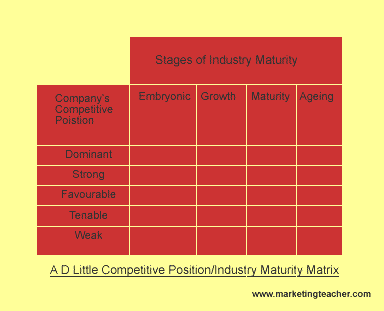The Arthur D Little (ADL) Strategic Condition Matrix
Although now slightly dated at first glance, The Arthur D Little (ADL) Strategic Condition Matrix offers a different perspective on strategy formulation. ADL has two main dimensions – competitive position and industry maturity.
Competitive position is driven by the sectors or segments in which a Strategic Business Unit (SBU) operates. The product or service which it markets, and the accesses it has to a range of geographically dispersed markets that are what makes up an organization’s competitive position i.e. product and place.
Industry maturity is very similar to the Product Life Cycle (PLC) and could almost be renamed an ‘industry life cycle.’ Of course not only industries could be considered here but also segments

It is a combination of the two aforementioned dimensions that helps us to use ADL for marketing decision-making. Now let’s consider options in more detail. Competitive position has five main categories:
- 1. Dominant – This is a particularly extraordinary position. Often this is associate with some form of monopoly position or customer lock-in e.g. Microsoft Windows being the dominant global operating system.
- 2. Strong – Here companies have a lot of freedom since position in an industry is comparatively
powerful e.g. Apple’s iPod products. - 3. Favourable – Companies with a favourable position tend to have competitive strengths in segments of a fragmented market place. No single global player controls all segments. Here product strengths and geographical advantages come into play.
- 4. Tenable – Here companies may face erosion by stronger competitors that have a favourable, strong or competitive position. It is difficult for them to compete since they do not have a sustainable competitive advantage.
- 5. Weak – As the term suggests companies in this undesirable space are in an unenviable position. Of course there are opportunities to change and improve, and therefore to take an organization to a more favourable, strong or even dominant position.
From here the strategic position of an organisation can be established. Managers then need to decide upon the best strategic direction for the business. For example they might use a Gap Analysis. According to ADL, there are six generic categories of strategy that could be employed by individual SBU’s:
- Market strategies.
- Product strategies.
- Management and systems strategies.
- Technology strategies.
- Retrenchment strategies.
- Operations strategies.
